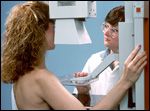Digital and Film-Screen Mammograms Found to be Equally Effective
A new prospective study has shown that cancer detection using digital film mammography has outcomes similar to the much less expensive film-screen mammography technique. Sensitivity of digital mammography was found to be higher, however, for specific subpopulation cohorts.
A new prospective study has shown that cancer detection using digital film mammography has outcomes similar to the much less expensive film-screen mammography technique. Sensitivity of digital mammography was found to be higher, however, for specific subpopulation cohorts.

The study was published in the October 18 issue of the Annals of Internal Medicine (Kerlikowske et al. “Comparative Effectiveness of Digital Versus Film-Screen Mammography in Community Practice in the United States: A Cohort Study” Vol. 155 no. 8 493-502).
Since there is a dearth of research examining the effectiveness of digital versus film-screen mammography among United States community practices, the research sought to address, using a prospective cohort, differences in sensitivity, specificity, cancer detection rates, and tumor outcomes for digital and film-screen mammography.
The sensitivity of digital mammography was significantly higher for women aged 60 to 69 years, 89.9% compared to 83.0%, respectively (P = .014). The digital technique was also better at detecting estrogen receptor-negative cancer (78.5% compared to 65.8%, P = 0.016). Sensitivity was borderline significantly higher for women between the ages of 40 and 49, for women with extremely dense breasts, and premenopausal or peri-menopausal women.
Sensitivity of film-screen mammography was borderline significantly higher for women between the ages of 50 and 59 years of age (P = .097). Specificity of the two techniques was similar by age (91% compared to 90.4%, P < .001) except in women aged 40 to 49 (88.0% compared to 89.7%, P < .001).
Karla Kerlikowske, MD, a professor at the University of California, San Francisco, and lead author on the study and colleagues showed that cancer detection rates were similar with both detection techniques, but based on the subpopulation analysis, recommends that women under 50 receive a digital mammogram. As the under-50 age group is more likely to have extremely dense breasts and estrogen receptor-negative breast cancer, digital mammography appears to be optimal for this age group. Dr. Kerlikowske believes that either technique is fine for any woman over the age of 50.
329,261 women between the ages of 40 and 79 years of age from four registries underwent over 200,000 digital and over 630,000 film-screen mammograms for the study. The study, performed by the National Cancer Institute-funded Breast Cancer Surveillance Consortium from 2000 until 2006, was funded by the National Institute of Health. 4,046 breast cancers were diagnosed within a year of and before the next exam.
In recent years, digital mammography has been much more heavily used, despite a comparable performance to the less-expensive film-based technique. Both Medicare and private insurers reimburse digital mammogram at a much higher rate. Cost, however, was not taken into account in this study.